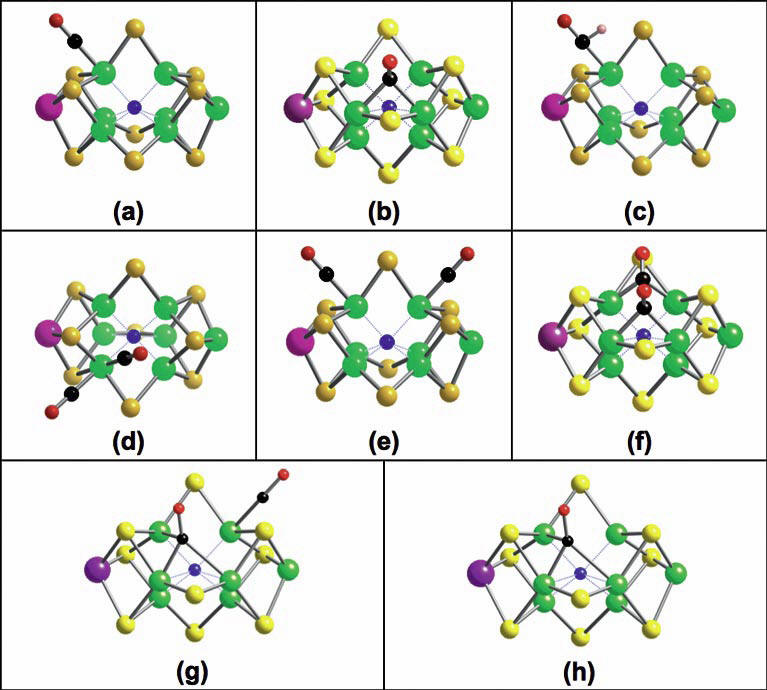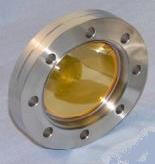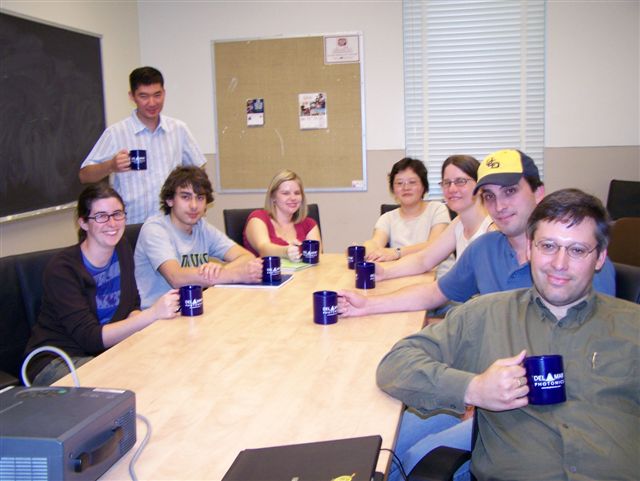
Del Mar Photonics - Newsletter December 2010 - Newsletter April 2011
Featured customer: Hongxin Wang
-
request a quote for custom optics
Photolysis of Hi-CO Nitrogenase – Observation of a Plethora of Distinct CO
Species Using Infrared Spectroscopy
Lifen Yan,[a] Christie H. Dapper,[b] Simon J. George,[a,c] Hongxin Wang,[a,c]
Devrani Mitra,[a] Weibing Dong,[a] William E. Newton,[b] and Stephen P.
Cramer*[a,c]
[a] Department of Applied Science, University of California, One Shields
Avenue, Davis, CA 95616, USA
[b] Department of Biochemistry, Virginia Polytechnic Institute and State
University, 123 Engel Hall, Blacksburg, VA 24061, USA
[c] Physical Biosciences Division, Lawrence Berkeley National Laboratory, 1
Cyclotron Road, MS 6R2100, Berkeley, CA 94720, USA
Keywords: Nitrogen fixation / Nitrogenases / Enzyme catalysis / Carbon monoxide
/ IR spectroscopy / Photolysis /Azotobacter vinelandii
Fourier-transform infrared-spectroscopy (FT-IR) was used to
study the photochemistry of CO-inhibited Azotobacter vinelandii
Mo nitrogenase using visible light at cryogenic temperatures.
The FT-IR difference spectrum of photolyzed hi-CO at 4 K comprises negative bands at 1973 cm–1 and
1679 cm–1 together with positive bands at 1711 cm–1, 2135
and 2123 cm–1. The negative bands are assigned to a hi-CO
state that comprises 2 metal-bound CO ligands, one terminally
bound, and one bridged and/or protonated species.
The positive band at 1711 cm–1 is assigned to a lo-CO product
with a single bridged and/or protonated metal-CO group.We term these species “Hi-1” and “Lo-1”, respectively. The
high-energy bands are assigned to a liberated CO trapped
in the protein pocket. Warming results in CO recombination,
and the temperature dependence of the recombination rate
yields an activation energy of 4 kJmol–1. Two !-H195 variant enzymes yielded additional signals. Asparagine substitution,
!-H195N, gives a spectrum containing 2 negative “Hi-2”
bands at 1936 and 1858 cm–1 with a positive “Lo-2” band at
1780 cm–1, while glutamine substitution, !-H195Q, produces
a complex spectrum that includes a third CO species, with
negative “Hi-3” bands at 1938 and 1911 cm–1 and a positive
feature “Lo-3” band at 1921 cm–1. These species can be assigned
to a combination of terminal, bridged, and possibly
protonated CO groups bound to the FeMo cofactor active
site. The proposed structures are discussed in terms of both
CO inhibition and the mechanism nitrogenase catalysis.
Given the intractability of observing nitrogenase intermediates
by crystallographic methods, IR-monitored photolysis
appears to be a promising and information-rich probe of
nitrogenase structure and chemistry.

Scheme 1. Proposed Fe-based modes of CO binding in N2ase: (a) single terminal
a-top CO,[6b] (b) single bridging CO,[8e] (c) “formyl” CO, (d) two terminal
a-top CO, same Fe,[6b] (e) two terminal a-top CO, different Fe,[8e] (f) two
bridging CO,[8h] (g) triple-bridging and terminal CO, (h) triple-bridging CO. Mo
histidine and homocitrate
ligands and cysteine thiolate ligand of Fe-1 have been omitted for clarity. No
attempt was made to relax the Fe-S framework for these structures. Atom color
codes: Fe green, Mo purple, S yellow, C black, O red. The undefined central atom
of FeMo-co is printed in blue.
Samples for FTIR analysis were placed in
custom cell holders with Teflon spacers and either zinc sulfide (Del
Mar Photonics) or cubic zirconia
windows. Typical pathlengths ranged from 50–15 μm. FTIR spectra were measured in
a Bruker VERTEX 70v FT-IR spectrometer equipped with a custom adapted Oxford
Instruments CF1208 liquid-helium flow cryostat. Photolysis with visible light
employed an Osram XENOPHOT® lamp (100 W) or a Sutter Instruments Lambda LS xenon
arc lamp (300 W).
Full article
Del Mar Photonics featured optical components - request a quote for custom optics
Del Mar Photonics continuously expands its optical components portfolio. Browse our online store, read monthly notes about our featured optical products or just send us your requirements or product ideas.
|
|
Axicon Lens Axicon lens also known as conical lens or rotationally symmetric prism is widely used in different scientific research and application. Axicon can be used to convert a parallel laser beam into a ring, to create a non diffractive Bessel beam or to focus a parallel beam into long focus depth. Del Mar Photonics supplies axicons with cone angles range from 130° to 179.5° for use with virtually any laser radiation. We manufacture and supply axicons made from BK7 glass, fused silica and other materials. buy online - download brochure |
 |
Rutile (TiO2) coupling
prisms Del Mar Photonics offers optical elements made of high quality synthetically grown Rutile Titanium Dioxide crystals. Rutile’s strong birefringency, wide transmission range and good mechanical properties make it suitable for fabrication of polarizing cubes, prisms and optical isolators. Boules having high optical transmission and homogeneity are grown by proprietary method. Typical boules have 10 - 15 mm in dia. and up to 25 mm length. Optical elements sizes - from 2 x 2 x 1 mm to 12.7 x 12.7 x 12.7 mm. Laser grade polish quality is available for finished elements. So far we the largest elements that we manufactured are 12 x15 x 5 mm, in which optical axis is parallel to 15 mm edge, 5 mm is along beam path, 12 x 15 mm faces polished 20/10 S/D, one wave flatness, parallelism < 3 arc.min. (better specs. available on request). more details - buy online - download brochure |
 |
Vacuum viewport Del Mar Photonics offer a range of competitively priced UHV viewports , Conflat, ISO or KF including a variety of coatings to enhance performance. Del Mar Photonics viewports are manufactured using advanced techniques for control of special and critical processes, including 100 percent helium leak testing and x-ray measurements for metallization control. Windows Materials include: Fused silica, Quartz , Sapphire , MgF2, BaF2, CaF2, ZnSe, ZnS, Ge, Si, Pyrex. Standard Viewing diameters from .55" to 1.94 ". Coating - a range of custom coatings can applied - which include - Single QWOT - Broad Band AR - V coatings - ITO - DLC (Diamond like coating) more details - request a quote |
 |
Manufacturing challenging optical components Our group works to characterize the interaction of biomolecules with solid surfaces, writes Dennis Hore of University of Victoria, Canada. Nature designs proteins with well-defined structures in solution. The conformation of these molecules may serve a structural purpose, or a chemical one in the case of enzymes. In order to further the progress of technologies that immobilize such molecules on synthetic surfaces (like biosensors employing enzymes), it is important to have a detailed understanding and control of the interactions of these molecules with the surface more For that project Del Mar has been able to manufacture all shapes of prisms from CaF2, fused silica, and ZnSe according to our custom specifications. Del Mar Photonics online store features windows, prisms, lenses, attenuators, etalons, crystals and wafers, and other items. Axicons, barium fluoride windows, germanium etalons, rutile (TiO2) prisms, microchannel plates and detectors, saturable absorber mirrors, photoconductive THz antennas, lithium niobate wafers and crystals and many other high quality affordable components for scientific research and OEM production are delivered globally from stock. Micro Prism from Del Mar Photonics - Concentrating Photovoltaics |
 |
We are looking forward to hear from you and help you with your optical and crystal components requirements. Need time to think about it? Drop us a line and we'll send you beautiful Del Mar Photonics mug (or two) so you can have a tea party with your colleagues and discuss your potential needs |
Trestles LH femtosecond lasers with integrated DPSS DMPLH laser pump - DPSS DMPLH lasers
| Zinc Selenide - ZnSe | |
| Zinc Selenide - ZnSe | |
![]()
| Displaying 1 to 20 (of 20 products) | Result Pages: 1 |
| PCX-CaF2-12.7-750 | IR Calcium Fluoride Plano-Convex Lens, ø 0.5", f = 750 mm |
|
| PCX-CaF2-12.7-1000 | IR Calcium Fluoride Plano-Convex Lens, ø 0.5", f = 1000 mm |
|
| PCX-CaF2-12.7-2000 | IR Calcium Fluoride Plano-Convex Lens, ø 0.5", f = 2000 mm |
|
| PCX-CaF2-25.4-50 | IR Calcium Fluoride Plano-Convex Lens, ø 1", f = 50 mm |
|
| PCX-CaF2-25.4-75 | IR Calcium Fluoride Plano-Convex Lens, ø 1", f = 75 mm |
|
| PCX-CaF2-25.4-150 | IR Calcium Fluoride Plano-Convex Lens, ø 1", f = 150 mm |
|
| PCX-CaF2-25.4-200 | IR Calcium Fluoride Plano-Convex Lens, ø 1", f = 200 mm |
|
| PCX-CaF2-25.4-250 | IR Calcium Fluoride Plano-Convex Lens, ø 1", f = 250 mm |
|
| PCX-CaF2-25.4-300 | IR Calcium Fluoride Plano-Convex Lens, ø 1", f = 300 mm |
|
| PCX-CaF2-25.4-400 | IR Calcium Fluoride Plano-Convex Lens, ø 1", f = 400 mm |
|
| PCX-CaF2-25.4-500 | IR Calcium Fluoride Plano-Convex Lens, ø 1", f = 500 mm |
|
| PCX-CaF2-25.4-750 | IR Calcium Fluoride Plano-Convex Lens, ø 1", f = 750 mm |
|
| PCX-CaF2-25.4-1000 | IR Calcium Fluoride Plano-Convex Lens, ø 1", f = 1000 mm |
|
| PCX-CaF2-25.4-2000 | IR Calcium Fluoride Plano-Convex Lens, ø 1", f = 2000 mm |
|
|
|||||||||||||||||||||||
|
|
|||||||||||||||||||||||
|
|||||||||||||||||||||||
If you can't find an optical component you are looking for just send us a quick e-mail and we'll direct you to the right standard item or quote custom component!